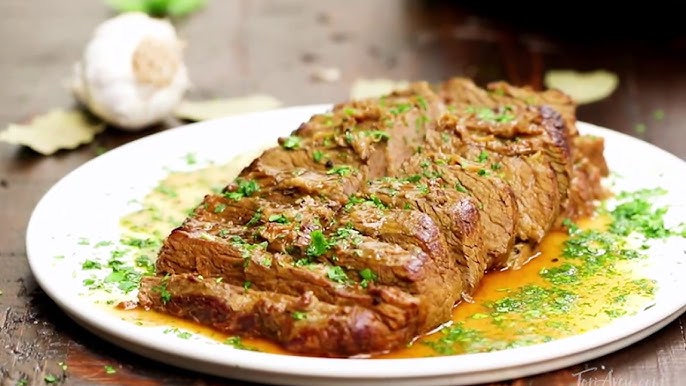Beef Brisket Recipe: If you’re looking for a dish that’s flavorful, juicy, and perfect for any gathering, beef brisket is the answer. Cooking brisket may seem intimidating at first, but with the right steps, anyone can make this tender and delicious dish.
In this guide, we’ll walk you through everything you need to know about making the perfect beef brisket from start to finish.
What is Beef Brisket?
Beef brisket is a large cut of meat that comes from the lower chest of a cow. It’s a tough piece of meat that requires slow cooking to break down its fibers and achieve that melt-in-your-mouth tenderness. Brisket is commonly used for BBQ, roasting, and even stews.
Why You Should Try Cooking Beef Brisket
Tender and Juicy Meat
Cooking beef brisket the right way transforms this tough cut of meat into an incredibly tender and juicy dish. The low and slow cooking method allows the meat’s connective tissue to break down gradually, leaving you with a rich, savory flavor.
Perfect for Gatherings
Beef brisket is a large cut of meat, making it ideal for serving at family dinners, holiday feasts, or backyard BBQs. It’s a showstopper that everyone will love.
Ingredients You Need for Beef Brisket
Main Ingredients
- 4-6 pounds of beef brisket
- 2 tablespoons of olive oil
- 1 tablespoon salt
- 1 tablespoon black pepper
- 2 tablespoons garlic powder
- 2 tablespoons onion powder
- 2 tablespoons paprika (smoked for added flavor)
Optional Add-Ons
- 1 teaspoon cayenne pepper for heat
- ½ cup beef broth for extra moisture
- 2 tablespoons brown sugar for a hint of sweetness
Essential Kitchen Tools for Cooking Brisket
To prepare beef brisket perfectly, here are the must-have tools:
- Sharp knife for trimming the brisket
- Mixing bowl for preparing the rub
- Aluminum foil or butcher paper for wrapping
- Meat thermometer to check doneness
- Roasting pan, smoker, or slow cooker
- Tongs for handling the brisket
How to Choose the Best Beef Brisket
Fresh vs. Frozen Brisket
Whenever possible, choose a fresh brisket. Fresh brisket ensures better texture and flavor compared to frozen cuts, which may lose moisture during thawing.
Prime vs. Choice Cut
Prime cuts have more marbling (fat content) and produce a juicier brisket. Choice cuts are leaner but still work well if cooked properly. Look for a brisket with even fat distribution across the top.
Step-by-Step Beef Brisket Recipe
Step 1: Preparing the Brisket
Start by trimming the brisket. Use a sharp knife to remove any excess fat, leaving about ¼ inch of fat on top. This thin layer of fat helps keep the meat moist during cooking.
Step 2: Seasoning the Brisket
Mix the salt, black pepper, garlic powder, onion powder, and paprika in a bowl. Rub the mixture generously all over the brisket. For added flavor, let the brisket sit in the fridge for 4-12 hours to allow the seasoning to penetrate.
Step 3: Preheating Your Oven or Smoker
Preheat your oven to 275°F (135°C). If using a smoker, set it to 225°F (107°C) for a traditional smoked brisket. Ensure the temperature stays consistent throughout the cooking process.
Step 4: Cooking the Brisket Slowly
- Place the brisket in a roasting pan or smoker, fat side up.
- Cover with aluminum foil or butcher paper after 3-4 hours of cooking to lock in moisture.
- Cook for 1 hour per pound of brisket until the internal temperature reaches 195-205°F (90-96°C).
Step 5: Letting the Brisket Rest
Once the brisket reaches the desired temperature, remove it from the oven or smoker and let it rest for 30-45 minutes. Resting allows the juices to redistribute, ensuring a moist and flavorful brisket.
Tips for Perfect Beef Brisket Every Time
Low and Slow Cooking
The key to tender brisket is cooking it at a low temperature for an extended time. This method breaks down the connective tissues without drying out the meat.
Properly Wrapping the Brisket
Wrapping the brisket during the cooking process (a technique called the “Texas crutch”) helps lock in moisture and speeds up the cooking process. Use butcher paper or aluminum foil for best results.
Different Cooking Methods for Beef Brisket
Oven Cooking
- Preheat the oven to 275°F.
- Place the brisket in a roasting pan, cover, and bake for 5-6 hours until tender.
Smoking the Brisket
- Use wood chips (oak, hickory, or mesquite) for a smoky flavor.
- Smoke the brisket at 225°F for 1 hour per pound until done.
Slow Cooker Method
- Place the brisket in a slow cooker with broth and seasonings.
- Cook on low for 8-10 hours until tender.
Best Seasonings and Rubs for Beef Brisket
The flavor of brisket largely depends on the seasoning you choose. A simple salt and pepper rub, known as the “Texas-style rub,” is a classic choice, but you can elevate the flavor profile with a variety of ingredients.
- Traditional Rub: Salt, black pepper, garlic powder, and onion powder.
- Sweet and Smoky Rub: Add smoked paprika, brown sugar, and cayenne pepper for a balance of sweetness and spice.
- Herb-Infused Rub: Incorporate thyme, rosemary, and oregano for a more aromatic twist.
- Spicy Rub: Use chili powder, cayenne pepper, and red pepper flakes for extra heat.
You can experiment with these rubs to find your favorite. Make sure to rub the seasoning generously and let the brisket rest so the flavors penetrate the meat.
How to Know When the Brisket is Done
The perfect brisket takes time, and knowing when it’s done is key to avoiding tough or undercooked meat. Here are a few ways to tell if your brisket is ready:
- Internal Temperature: Use a meat thermometer to check the brisket. The ideal internal temperature is between 195°F and 205°F. At this temperature, the connective tissue breaks down, making the meat tender.
- The “Probe Test”: Insert a fork or knife into the meat. If it slides in without resistance, the brisket is done.
- Texture: A properly cooked brisket should have a soft, buttery texture when sliced.
Don’t rush the process—low and slow is the way to achieve the perfect brisket.
Serving Suggestions for Beef Brisket
Brisket is incredibly versatile and pairs well with a variety of side dishes and sauces.
Side Dishes to Pair with Brisket
- Coleslaw: A crunchy, refreshing salad that balances the richness of brisket.
- Mac and Cheese: Creamy, cheesy mac and cheese is a comforting companion to brisket.
- Cornbread: Soft, buttery cornbread is a classic pairing with BBQ brisket.
- Roasted Vegetables: Carrots, potatoes, and green beans complement the flavors of slow-cooked brisket.
Sauces to Serve
- BBQ Sauce: Tangy, smoky BBQ sauce is a go-to option.
- Chimichurri: A fresh, herb-based sauce that adds brightness to the dish.
- Horseradish Sauce: A creamy, slightly spicy sauce that pairs well with brisket.
Slice the brisket against the grain to ensure maximum tenderness and serve it alongside these delicious sides for a complete meal.
Common Mistakes to Avoid While Cooking Brisket
Cooking brisket can be tricky, especially for beginners. Avoid these common mistakes:
- Skipping the Trim: Failing to trim excess fat can lead to a greasy brisket.
- Not Seasoning Enough: Brisket is a large cut of meat and needs plenty of seasoning to enhance its flavor.
- Cooking at High Temperatures: Cooking brisket too quickly will leave it tough and dry. Stick to low and slow cooking.
- Skipping the Resting Time: Let the brisket rest for at least 30 minutes after cooking. This ensures the juices redistribute properly.
- Slicing It Incorrectly: Always slice the brisket against the grain to achieve tender, easy-to-chew slices.
Storing and Reheating Leftover Brisket
Brisket tastes just as good the next day—if not better! Here’s how to store and reheat leftover brisket:
Storing Brisket:
- Wrap the leftover brisket tightly in aluminum foil or plastic wrap.
- Place it in an airtight container and store it in the refrigerator for up to 4 days.
- For longer storage, freeze the brisket for up to 3 months.
Reheating Brisket:
- Oven Method: Preheat your oven to 300°F. Place the brisket in a baking dish, cover with foil, and reheat for 20-30 minutes.
- Stovetop Method: Slice the brisket and heat it gently in a skillet with a splash of beef broth to keep it moist.
- Microwave: Reheat in short intervals (30-45 seconds) to prevent overcooking.
When reheating, make sure the brisket stays moist by adding a little broth or drippings.
Health Benefits of Beef Brisket
While brisket is often seen as indulgent, it also offers a variety of nutritional benefits:
- High Protein Content: Brisket is a great source of protein, which supports muscle growth and repair.
- Rich in Nutrients: It provides essential nutrients like iron, zinc, and B vitamins that are vital for energy production and overall health.
- Healthy Fats: Brisket contains healthy fats that can boost energy levels when consumed in moderation.
To make brisket healthier, pair it with nutrient-rich vegetables and avoid sugary or fatty sauces.
FAQs about Beef Brisket Recipe
1. What is beef brisket?
Beef brisket is a cut of meat from the breast or lower chest of beef cattle. It is known for its rich flavor and fibrous texture, making it ideal for slow-cooking methods such as smoking, braising, or slow-roasting.
2. How long should you cook a beef brisket?
The cooking time for beef brisket depends on the method used. For smoking, expect to cook it for about 1 to 1.5 hours per pound at 225°F (107°C). Braising in the oven typically takes about 3 hours at 300°F (150°C) for a 3-pound brisket.
3. Should I marinate beef brisket before cooking?
Marinating beef brisket can enhance its flavor and tenderness. A marinade of oil, vinegar, herbs, and spices for at least a few hours or overnight is recommended, especially if you plan to roast or smoke the brisket.
4. What internal temperature should beef brisket reach?
Beef brisket is optimally tender and safe to eat when its internal temperature reaches 195°F to 205°F (90°C to 96°C). Use a meat thermometer to accurately gauge the temperature.
5. Can beef brisket be cooked in a slow cooker?
Yes, cooking beef brisket in a slow cooker is an excellent way to achieve a tender, flavorful dish. Cook it on low for 8-10 hours or on high for 4-6 hours with enough liquid to partially submerge the meat.
6. What are the best seasonings for beef brisket?
Common seasonings include salt, black pepper, garlic powder, onion powder, and smoked paprika. For a more complex flavor, you can add cumin, coriander, or dried herbs like thyme and rosemary.
7. How should I slice beef brisket?
Always slice beef brisket against the grain of the meat. This cuts through the muscle fibers, making the brisket more tender and easier to eat.
8. How can I store leftover beef brisket?
Leftover beef brisket can be stored in an airtight container in the refrigerator for up to 4 days. You can also freeze it for up to 3 months. When ready to eat, reheat gently to maintain its moisture and texture.
Conclusion
Beef brisket might require a little patience, but the result is worth every minute. By following this step-by-step guide, you’ll be able to cook a tender, juicy, and flavorful brisket that’s perfect for family dinners, BBQs, or special gatherings. Whether you choose to smoke, bake, or slow-cook it, brisket is sure to impress your guests and satisfy your taste buds.



